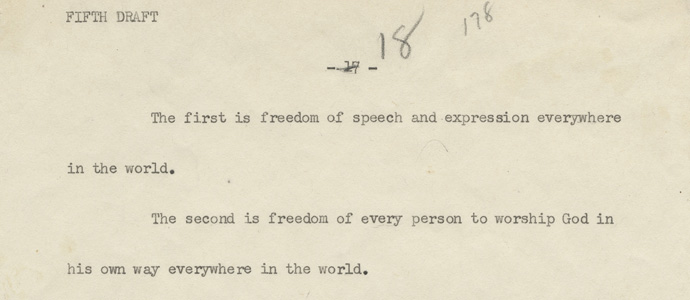 Webtartalom-megjelenítő
Webtartalom-megjelenítő
Four Freedoms Curriculum Hub

- Historic Context
- Central Issue
- Key Questions
- Primary Sources
- Classroom Activities
- Links for More Information
- Distance Learning Opportunities
Historic Context
For the United States and other democratic nations, the 1930s was a time of growing peril.
Across the globe, economic depression bred mass unemployment and despair. In some nations, financial strife aided the rise of totalitarian leaders. These leaders offered simple solutions to their countries’ problems, solutions based on military expansion, extreme nationalism, political violence, and doctrines of racial superiority.
Between 1931 and 1939, totalitarian nations in Europe and Asia embarked on paths of aggression and military conquest.
In Europe, German dictator Adolf Hitler and his Italian counterpart, Benito Mussolini, began to threaten their neighbors. In Asia, the military-dominated government of Japan, hungry for land and raw materials, plotted a path of territorial expansion.
As the decade progressed events overseas cast an ever-widening shadow over America. Increasingly, FDR and the nation found their attention drawn away from domestic economic concerns.
At first, the democratic nations reacted meekly to these acts of aggression. But by 1939, Britain and France were determined to resist Hitler. They pledged to come to Poland’s defense if Germany attacked. FDR wanted to deter international aggression. He believed America’s physical distance from Europe and Asia no longer assured its long-term security from foreign threats. But his ability to act was severely restricted by deep-seated American isolationism.
Since the nation’s birth, the bedrock of American foreign policy was avoiding entanglement in foreign military alliances and conflicts. While Americans sympathized with the victims of aggression, most felt overseas troubles had little to do with their country’s national security. Many regretted American involvement in World War I. Concerned about economic difficulties at home, they hoped to stay out of international disputes.
With public opinion limiting his options, FDR proceeded with caution. He spoke out against violations of international law, but avoided a direct confrontation with the isolationists.
Central Issue
“In the future days, which we seek to make secure, we look forward to a world founded upon four essential human freedoms."
-Franklin Roosevelt, Annual Message to Congress, January 6, 1941
In the early days of World War II, FDR began to frame the conflict in universal terms—as a struggle to defend freedom everywhere in the world. His most enduring expression of this concept came in a January 6, 1941 speech to Congress in which he envisioned “a world founded upon four essential human freedoms.” These were: “freedom of speech and expression,” “freedom of every person to worship God in his own way,” “freedom from want,” and “freedom from fear.”
Roosevelt’s Four Freedoms became a powerful statement of Allied war aims. Artist Norman Rockwell later depicted them in a famous series of paintings. When America entered the war the paintings were featured on posters promoting war bonds that helped finance the fighting.
Key Questions
1)What do the Four Freedoms say about fundamental American values?
2)Why did Roosevelt feel the need to articulate the Four Freedoms at that time in world History?
3)How does each of the Four Freedoms support the others?
4)Were Roosevelt to have included a “Fifth Freedom” - what might it have been?
5)FDR offered the Four Freedoms as the Allies vision for the world; what was the Axis Powers’ vision?
Primary Sources
Audio Visual
Classroom Activities
Classroom activities for students
Links for More Information
Four Freedoms
https://edsitement.neh.gov/lesson-plan/fdrs-four-freedoms-speech-freedom-fireside
http://fdr4freedoms.org/four-freedoms/
http://americanrhetoric.com/speeches/fdrthefourfreedoms.htm
http://www.fdrfourfreedomspark.org/fdr-the-four-freedoms/
https://www.archives.gov/exhibits/powers_of_persuasion/four_freedoms/four_freedoms.html
https://www.facinghistory.org/universal-declaration-human-rights/four-freedoms-speech
Distance Learning Opportunities
Onsite and Online
Four Freedoms Presentations
The Roosevelt Presidential Library and Museum offers onsite and online interactive presentations about the Four Freedoms.
All presentations are curriculum centered and developed using documents, photographs and reproduction artifacts selected from the Roosevelt Presidential Archives consisting of 17 and a half million pages of documents, more than 130,000 photographs, 35,000 artifacts, and nearly 50,000 books… 22,000 of which are from FDR’s personal book collection.
Each session consists of a 15-20 minute presentation followed by a 15-20 minute question and answer period where you and your students get to follow up and cross examine with whatever questions, or comments you may have regarding the Four Freedoms.
Sessions can be delivered via skype, Poly Com Zoom Room or Google Hang Out. And they are all offered free of charge!!
For more information about scheduling a session with your class contact the Library’s education specialist at: Jeffrey Urbin at (845) 486-7751 or Jeffrey.urbin@nara.gov



